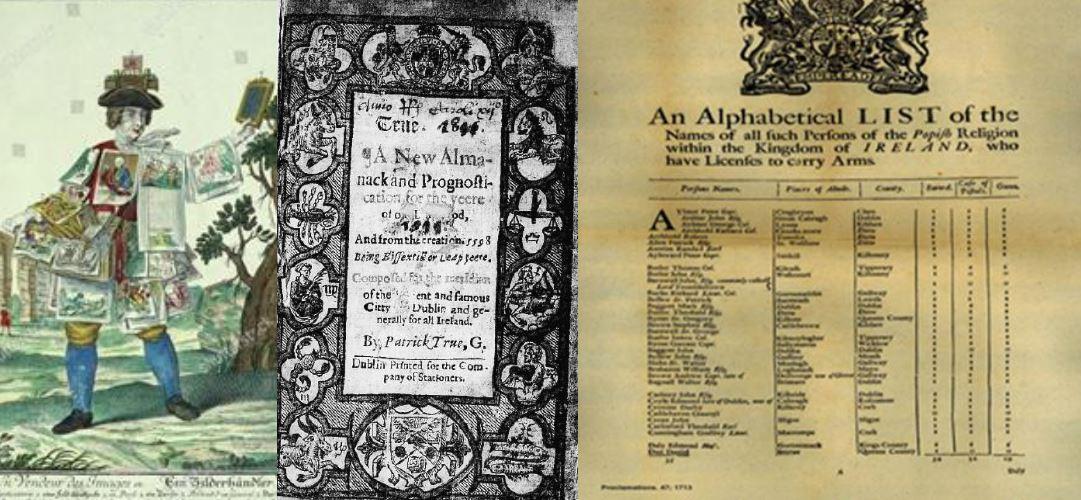Week 4: Evidence in Popular Print

- Fiona Fitzsimons, Genealogist, Irish Family History Centre
Printed material captures a greater sweep of the Irish population, of all backgrounds and at an earlier time, than many official/ transactional archival documents.
Almanacks/ Directories
Almanacks and calendars were some of the earliest books printed for a popular audience.
These were reference works that carried basic but essential information.
They included events that would happen in the next year including tide-tables; dates of eclipses; phases of the moon; saints days and religious festivals.
As well as calendars for planting crops, the dates of fairs and markets; or the dates when the Assizes Courts would sit locally.
Dublin City Library’s collection of almanacks and directories (Pearse St.) is digitised and published online on Findmypast.
Post-chaise Companions
In the 1700s new print formats were developed for popular audiences, including Gazetteers and Court Directories.
A Gazetteer is a geographical dictionary used with a map or atlas.
Typically it has information about the geography of a region, and includes social statistics and physical features.
We have Taylor & Skinners Maps published 1776-7, 1783 for Ireland.
Irish Family History Centre www.irishfamilyhistorycentre.com Ph: 00353 19059216 / Office 6710338 CHQ Building, 1 Custom House Quay, North Dock, Dublin, Ireland. Copyright © asserted.
And Wilson’s Post Chaise companion 1786. (Post chaise was a stage-coach)
In the 1820s/30s the advent of the railways brought an end to these ‘companions.’
Commercial Directories
The first commercial directory in Ireland was Wilson’s Dublin Directory published in 1752.
Directories included the names and addresses of the main inhabitants of a town or city, their status and occupation. Many, include street-directories, as well as professional and trade listings.
They were ‘bundled’ with an Almanacks, Gazetteers and Court Directories to widen their appeal and increase sales. By the 1820s, directories in Ireland provided national coverage.
The most complete online collection of directories for all Ireland *(including present-day Northern Ireland) is on Findmypast.
Newspapers
Newspapers were urban – they appeared wherever there was a high turnover of people on the move.
In the early 19th Century a network of print spread rapidly, and by the 1830s every county in Ireland had at least one local newspaper.
The largest collection of Irish newspapers online is The British Newspaper Archive. It includes a newspaper for every Irish county, and a complete run of the Irish Times. It’s available through the Findmypast website.
Irish Newspaper Archives is a subscription website containing historic newspapers owned by the Independent Newsgroup. https://www.irishnewsarchive.com
Is there a method to searching newspapers?
Newspapers aren’t indexed as historical records are. Instead we use Optical Character Recognition. It’s an imperfect technology.
Try a few different search terms, and combinations of search terms
Advanced search:
- Use quotation marks to search for a phrase eg: "Land League"
- Use the search-filters on the British Newspaper Archive site.
You can filter by
- date (1-15 June 1850),
- newspaper (eg: Clonmel Herald),
- type of story (article/ advertisement/ family notice/ illustrated); or
- public tags (advertisement and notices/ News/ sports and games/ crime and punishment)